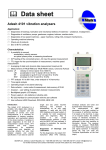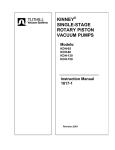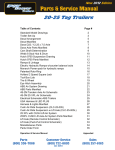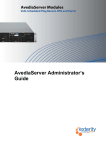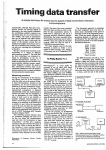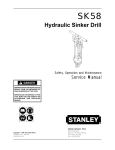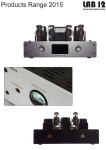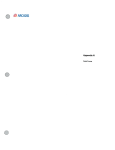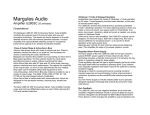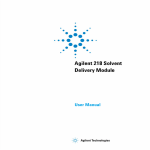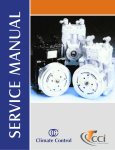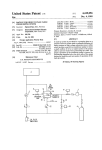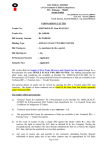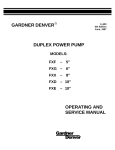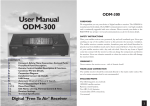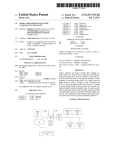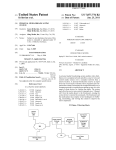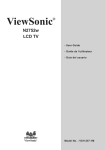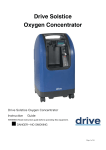Download MANUAL KINNEY® KT™ SERIES - Ideal Vacuum Products, LLC
Transcript
Manual 1843-1 KINNEY KT SERIES ® ™ Single Stage, Triplex Rotary Piston Pumps Models KT-150 KT-300 KT-500 KT-850 INSTALLATION OPERATION MAINTENANCE REPAIR MANUAL WARNING DO NOT OPERATE BEFORE READING MANUAL. ADVANCING THE STANDARDS IN VACUUM TECHNOLOGY 4840 West Kearney Street Springfield, Missouri USA 65803-8702 Tel 417 865-8715 800 825-6937 Fax 417 865-0307 E-mail: [email protected] 06/2003 http://vacuum.tuthill.com ! WARNING ! CAUTION DO NOT VALVE OR RESTRICT PUMP DISCHARGE OPENING. DO NOT OPERATE WITHOUT BELT GUARD USE OIL MIST ELIMINATOR WHEN OPERATING PUMP. ENSURE ADEQUATE VENTILATION WHEN DISCHARGING INDOORS. REFER TO MANUAL SAFETY INSTRUCTIONS. 809762-A000 NOTICE The above safety instruction tags were permanently affixed to your pump prior to shipment. Do not remove, paint over or obscure in any manner. Failure to heed these warnings could result in serious bodily injury to the personnel operating and maintaining this SAFETY PRECAUTIONS FOR ROTARY PISTON PUMPS Please read the following safety information on this page before operating your vacuum pump. 2 • Do not operate the pump without the belt guard properly attached. Disconnect the pump motor from the electrical supply at the main disconnect before removing the belt guard. Replace the belt guard before reconnecting the power supply to the pump motor. Operating the pump without the belt guard properly installed exposes personnel in the vicinity of the pump to risk from rotating drive components. • Do not operate the pump with oxygen-enriched gas (greater than 20% by volume) in the suction line, unless the pump has been prepared with an inert fluid suitable for the application. Pumping oxygen-enriched gases with mineral oil or other non-inert fluids can cause fire or explosion in the pump, resulting in damage or serious bodily injury. • Take precautions to avoid prolonged or excessive exposure to oil mist or process materials emanating from the discharge of the pump. • Do not allow the pump to discharge into a closed, or inadequately ventilated room. Always use a discharge oil mist eliminator unless the pump discharge is discharged to outside atmosphere. Laws and ordinances may pertain to your local area regarding discharge of oil mist or vapor to atmosphere. Check local laws and ordinances prior to operation of the pump with discharge to outside atmosphere. Venting of the discharge of an oil mist eliminator to outside atmosphere is highly recommended. • Do not restrict the pump discharge in any way, or place valves in the discharge line. The vacuum pump is a compressor and will generate high pressures without stalling the motor when operated at low suction pressures. Excessive pressure could cause damage or serious bodily injury. • Disconnect the pump motor from the electrical supply at the main disconnect before disassembling or servicing the pump. Make sure pump is completely reassembled, the belt guard is properly installed, and that all fill and drain valves are installed and closed before reconnecting the power supply. Accidental starting or operation of the pump while maintenance is in progress could cause damage or serious bodily injury. • Lift pump only by the lifting lugs supplied with the pump. DO NOT lift equipment attached to pump by the pump lifting lugs. • Do not touch hot surfaces on the pump. In normal operation at low pressures, surface temperatures will not normally exceed 180° F (82° C). Prolonged operation at 200 Torr (267 mbar a) may cause surface temperatures as high as 220° F (104° C) TABLE OF CONTENTS SECTION SAFETY PRECAUTIONS AND WARNINGS INTRODUCTION DESCRIPTION Specifications Description INSTALLATION Installing the Vibramounts Suction Manifolding Proper Venting Discharge Manifolding Cooling Water Filling the Pump with Oil Vacuum Gauges Electrical Connections OPERATION General Prestart Checks Starting The Pump Stopping The Pump Handling Large Quantities of Water Gas Ballast MAINTENANCE General Periodic Maintenance Oil Contamination Changing the Oil Lubricating the Pump Stalling Pump Leaks Checking Pump Performance Checking Process Equipment Discharging Valves Shaft-Seal Assembly V-Belt Drive DISASSEMBLY ASSEMBLY 2 4 5 6 7 8 9 9 9 11 12 12 12 12 13 13 13 14 14 14 14 15 15 16 16 16 16 17 19 19 20 20-21 Replacement Parts 22 Recommended Oil 22 Troubleshooting Chart 23 Parts List & Exploded Views WARRANTY STATEMENT 24-29 30 3 INTRODUCTION CONGRATULATIONS on your purchase of a new KINNEY® KT™ Single-Stage, Tri-plex Rotary Piston Vacuum Pump from Tuthill Vacuum & Blower Systems. Please examine the pump for shipping damage, and if any damage is found, report it immediately to the carrier. If the pump is to be installed at a later date make sure it is stored in a clean, dry location and rotated regularly. Make sure covers are kept on all openings. If pump is stored outdoors be sure to protect it from weather and corrosion. KINNEY KT vacuum pumps are built to exacting standards and if properly installed and maintained will provide many years of reliable service. We urge you to take time to read and follow every step of these instructions when installing and maintaining your pump. We have tried to make these instructions as straightforward as possible. We realize getting any new piece of equipment up and running in as little time as possible is imperative to production. WARNING: Serious injury can result from operating or repairing this machine without first reading the service manual and taking adequate safety precautions. IMPORTANT: Record the pump model and serial numbers in the OPERATING DATA form below. You will save time and expense by including this reference identification on any replacement part orders, or if you require service or application assistance. OPERATING DATA It is to the user’s advantage to have the requested data filled in below and available in the event a problem should develop in the blower or the system. This information is also helpful when ordering spare parts. Model No. __________________________________ V-Belt Size ______________ Length _____________ Serial No. __________________________________ (Recorded from nameplate on unit) Type of Lubrication: _____________________________ Startup Date ________________________________ ________________________ Pump RPM ________________________________ Operating Vacuum ____________________________ Pump Sheave Diameter ______________________ Any other special accessories supplied or in use: Motor Sheave Diameter _______________________ Motor RPM _______________ NOTES: 4 HP ______________ ___________________________________________ KINNEY® KT™ SERIES MANUAL 1843-1 © 2003, Tuthill Corporation INTRODUCTION This manual applies to Kinney Vacuum models KT-150, KT-300, KT-500 and KT-850. You should be thoroughly familiar with these instructions before attempting to install, operate or repair this unit. Consult Tuthill Vacuum & Blower Systems when problems arise that cannot be resolved after reading this manual. Always include pump nameplate information when ordering parts or components. SPECIFICATIONS KT-150 KT-300 KT-500 KT-850 150 255 300 510 490 840 780 1325 Pump Speed (rpm) RPM 1055 870 721 581 Motor speed at 50 RPM Hz 1,500 1,500 1,500 1,500 Motor speed at 60 RPM Hz 1,800 1,800 1,800 1,800 Motor Power 7.5 15 30 40 Oil Capacity (total/ US gal. refill) Liters 6/5 23/19 10/8.5 38/32 15/12.5 57/47 28/25 106/95 Cooling water at 60° F (16° C) 1/4 1.5/6 2.5/9 3.5/13 Cooling Water Inlet Inch NPT 1/4” 3/8” 3/8” 3/8” Suction, 150 lb. ANSI Flanged 3 4 6 8 Discharge, 150 lb. ANSI Flanged 2 3 4 5 Height w/o oil mist Inches eliminator mm 43 1092 51 1295 63 1600 71 1803 Floor Space Inches mm 24x26 609x660 27x34 686x864 34x38 864x965 38x49 965x1245 Weight Lbs Kg 800 363 1,525 692 2,625 1,191 4,175 1,894 Ultimate Pressure Microns 10 10 10 10 71 72 73 75 Free Air Displacement CFM m³/h HP Gpm L/min Noise Level dBA (Typical at 10 Torr) 5 Description The KT-Series pumps covered herein have an oil circulating pump to provide adequate lubrication at all pressures including atmosphere. The vacuum pump has three cams and pistons pumping in parallel, driven by a common shaft. The cams are positioned on the shaft so as to dynamically balance moving parts. This balancing technique applied to the Rotary Piston Principle was developed by Tuthill Vacuum & Blower Systems and virtually eliminated vibration. Figure 1. shows a cross section of the pump with the pistons being driven by the cams and revolving within the cylinder. Gas is drawn into the pump through a common inlet, channeled to the three piston slides and into the space behind the pistons as they rotate. The gas ahead of the pistons is compressed and forced out the discharge valves. As the gas is forced through the pump, sealing oil is mixed with the discharged gas and the discharged mixture is channeled into the separator, which is located in the reservoir, and there the gas is separated from the oil. Sealing and lubricating oil is provided by the oil pump which is mounted on the non-drive ahead and driven by direct coupling to the vacuum pump drive shaft. The oil pump provides forced feed oil circulation at all operating pressures including atmosphere. All models have a channeled drive shaft with an opening at each cam to distribute oil through the pump. Oil is taken from the reservoir at a point some distance above the reservoir bottom. This provides an area for impurities to collect for draining. Key to Figure 1. 1. Air/Oil Separator 2. Oil Level 3. Connection for optional temperature switch 4. Connection for optional temperature gauge 5. Connection for “scum” take-off 6. Pump Inlet 7. Slide Pin 8. Water cooling jacket 9. (Far Side) Cooling Jacket drain 1 of 2 10. Mounting Pads 11. Discharge Valve 12. Gas Ballast Valve 13. Oil Drain 14. Piston Slide 15. Shaft 16. Piston 17. Cam 18. Connection for optional heater 19. Cooling jacket drain 2 of 2 Figure 1. Cross Section of KT Series Vacuum Pump 6 INSTALLATION General Installing the Vibramounts KT pumps are supplied with vibramounts (vibrasprings on the KT-850) which enable them to run quietly and vibration free. The pump can be operated on any floor which will support its weight. The pump must be installed on the vibramounts and flexible connectors fitted in suction, discharge, water and electrical connections. It is not necessary to bolt the pump to the floor. If the studs are not already installed into the vibramounts, thread the short end into the top of the mount (smaller diameter) up to the spacer portion of the stud. The vibramount attachment holes are the four open threaded holes in the flanged edges of the cylinder, in line with the bottom plate/cylinder bolts, just in from each corner of the pump. DO NOT USE THE FOUR UNTHREADED HOLES WHICH ARE USED FOR SHIPMENT ONLY. With the pump lifted off the ground, thread the vibramounts with studs into the vibramount attachment holes until contact is made between the top of the vibramount and the cylinder bottom plate, and the foot location is parallel to the pump shaft. Care must be taken to set the pump down squarely on the mounts when installing the pump in operating position. Key to Figure 2. 1. Vacuum Gauge 2. Isolation Valve 3. Air Vent Valve 4. Shut Off Valve 5. Pump Suction Flange 6. To System 7. Right angle flexible connector 8. Trap drain Figure 2. Detailed Manifold Arrangement 7 Key to Figure 3. 1. Oil Mist Eliminator 2. Oil Return Line 3. Gas Ballast Assembly (standard arrangement) Figure 3. Oil Return to the Gas Ballast Valve Suction Manifolding Inlet manifolding should be sized and designed with four objectives in mind: A. B. C. D. To avoid gas flow restrictions. To prevent pump fluids from entering the process chamber. To protect the pump from the ingestion of particulate matter. To allow proper venting of the pump and suction manifold. Under the normal conditions, the diameter of the manifolding should not be less than the diameter of the pump connection and the pipe length should be kept to a minimum. Oil may splash from inside the pump through the suction port so the suction line must be designed to prevent oil from collecting there and draining back to the system or process. See Figure 2 for recommended arrangements as a guide for fabricating inlet manifolding. A flexible connection should be installed in the suction manifold to provide freedom for vibramounts. The vacuum piping must be well aligned with the pump connections so as not to place a strain on the piping. Provisions for gauge installation and any other drilling in the piping must be made prior to piping installation, otherwise, drilling particles entering the piping could be entrained into the pump. A vacuum isolation valve should be installed adjacent to the suction port to be used for leak checking, shutting down the system, or blanking off the pump. Before connecting the suction manifolding, distribute 4 quarts of oil over the three slide pins. This will necessitate reaching through the suction port with a container and pouring oil directly onto the slide pins. Then rotate the pump by hand a minimum of two revolutions to distribute the oil throughout the pump interior. During the initial operation and as long thereafter as necessary, a fine mesh screen should be installed across the inlet connection to prevent abrasive or solid particles left in the line from being sucked into the pump. This screen can be removed when particles no longer accumulate. If particles continue to accumulate, a filter should be installed in the line. 8 Proper Venting The Vacuum pump must be properly vented to ensure all oil is removed from the pumping chamber before the pump is turned off. Also, the suction line must be properly vented to ensure oil does not migrate into the process chamber. Recommended vent valve sizes: KT-150 KT-300 KT-500 KT-850 .75 inch 1.0 inch 1.5 inches 2.0 inches The vent valve must be open for at least 10 seconds before the pump is turned off to remove all oil from the pumping chamber. Discharge Manifolding Discharge manifolding should be sized and designed to prevent the following: A. Return of oil mist condensate to the pump B. Oil loss C. Oil mist in the discharged gas. Under the normal conditions, the diameter of the manifolding should not be less than the diameter of the pump connection and pipe length should be kept to a minimum. The installation of a Kinney oil mist eliminator on the discharge is recommended for all applications, (as shown in Figure 4). Oil which collects in the eliminator should be returned to the pump. The optional oil return kit will drain allow oil to back into the separator housing when the pump is operating at low pressure or when the pump is stopped. If the pump is to operate continuously, or normal operating pressure is between 10 torr (13 mbar) and 150 torr (200 mbar), the oil return should be connected to the gas ballast as shown in Figure 3. Over 150 torr (200 mbar) the oil return should be connected to the pump inlet. It may be necessary to pipe the pump exhaust fumes away from the pump area, such as outdoors. If this is done, the piping must be arranged to prevent line condensation from returning to the pump. A flexible connector should be fitted in the discharge line to provide freedom for the vibramounts. Cooling Water The cylinder cooling water jacket is shipped dry, with the drain plugs removed. They are tied to the pump in a small cloth bag. Replace the plugs in the positions shown in Figure 1 and fill the water jacket before starting the pump. If an optional water flow modulating valve (Water Miser) is fitted, the cylinder may take 20 minutes or more to fill. The delay can be avoided by lifting the spring to open the valve. For installation of the valve see Figure 6. Failure to ensure that the cooling water jacket is filled before starting the pump will result in localized over-heating of the pump and cause extensive damage. For installations requiring starting at ambient temperatures lower than 60°F (16°C), electric heaters should be installed in the water jacket. (See Figure 5.) 9 Key to Figure 4. 1. Discharge connection 2. Relief Valve 3. Top cover gasket 4. Element 5. Oil Drain Connection 6. Optional oil drain line kit 7. Oil Return connection Figure 4. Oil Mist Eliminator DO NOT ALLOW THE COOLING WATER TO FREEZE IN THE PUMP. Freezing of the cooling water jacket usually results in extensive damage to the pump cylinder which cannot be repaired. Connect a water supply line with “on-off” valve to the water inlet, and an open drain to the water outlet. The inlet line should have a flow regulating valve. If the water supply unreliable, it is advisable to install a flow switch to stop the pump or signal when the flow is interrupted. Normally the cooling water will be off when the pump is not running. A water pressure relief valve is fitted in the water jacket. This relief valve is set to open at 50 PSIG (3.5 bar). Standard cooling water rates are for up to 80°F (26°C) supply temperature and operation within the design continuous operating pressure range of .1 to 100 Torr (.13-130 mbar a). Sustained operation above 100 torr (130 mbar) and/or long pump downs generally require larger cooling water flow rate and/or external oil heat exchanger. Larger cooling water rate increases cooling efficiency reduces heat dissipation to room and keeps oil cooler Key to Figure 5. 1. Heaters 2. For 460 volts 3. For 430 volts 4. Switch 5. Input (fuse protected) 6. Temperature Gauge 7. Optional temperature switch 8. Install (1) heater into ¾ NPT tap far side (½ NPT on KT150, 300) 9. Install (1) heater into ¾ NPT tap this side (½ NPT on KT150, 300) Before energizing heaters: 1. Be sure water jacket is filled. 2. Turn off cooling water supply. 3. Do not restrict cooling water outlet. Pump KT-150 KT-300 KT-500 KT-850 Figure 5. Water Jacket Heater Installation 10 Heaters (2) 300W (2) 500W (2) 750W (2) 1000W P/N 074501-0000 074502-0000 074503-0000 074504-0000 Key to Figure 6 1. Waterflow modulating valve (water miser) 2. Temperature sensing bulb 3. Oil Temperature gauge 4. Water Inlet (3/8 NPT) 5. Water outlet (do not restrict or valve) 6. Nipple 7. Reducing bushing Model Water Miser Orifice Size Nipple Reducing Bushing KT-150 808009 A000 .032” 057222 00ST 055003 00ST KT-300 808009 A000 .032” 05719 00ST — KT-500 808247 A000 .062” 057603 00ST 055053MI KT-850 808247 A000 .062” 057603 00ST 055053MI Figure 6. Water Jacket Heater Installation Filling the Pump with Oil For initial oil filling and the first filling after the pump has been disassembled, the quantity of oil to be placed in the reservoir is one gallon less than shown in the specifications. One gallon is required in the suction port as outlined in “Suction Manifolding”. Use oil recommended by TVBS and see the specifications for the quantity of oil required to fill the pump. Remove the filler plug at the top of the separator housing and add oil until the level reaches the top of the sight gauge. The level will drop to below mid-center of the gauge once the pump is operated at blank off and the oil is distributed. Add or drain oil as necessary, to keep the oil level at blank off 3/8 inch (1 cm) up from the bottom of the glass. The oil level changes with operating pressure, reaching the lowest level at blank-off. CAUTION: Do not overfill the pump as excess oil will be blown out during the high pressure operation of the pump. 11 Vacuum Gauges The vacuum gauge(s) to be installed on the pump must be selected to meet the requirements of the particular pump application. Two general types of vacuum gauges are used for the testing of vacuum equipment, total pressure reading, such as thermistor or thermocouple gauges, and partial pressure reading McLeod gauges. The McLeod gauge indicates the partial pressure of permanent gasses. It does not indicate the component of pressure due to vapor such as water vapor. It is not greatly affected by vapor contamination unless the contamination pressure is quite high. It is most useful in confirming pump performance and for determining the absence or presence of leaks. A high thermistor or thermocouple gauge reading may indicate that the pump is contaminated or that it leaks, or both. A high McLeod gauge reading means that a leak is present. Electrical Connections WARNING: Disconnect pump from source electrical power prior to making repairs or adjustments of any electric component of the unit. If the pump is not wired when received, wire the motor as per the schematic/label on motor. Also wire any optional controls prior to start-up. When wiring is complete turn the pump by hand to ensure that the pump is free to turn and them momentarily jog the motor to check that the pump rotation direction is clockwise when facing the drive end. If the pump rotates in the wrong direction reverse any two of the three motor leads. If a flow switch is provided it should be wired into the motor circuit with a relay so as to stop the motor in the event the cooling water flow is interrupted. Optional custom control panels and electrical accessory components, along with schematic wiring diagrams and wiring instructions are available separately from Tuthill Vacuum & Blower Systems. OPERATION General WARNING: Do not operate the pump in an enclosed area unless the pump discharge is filtered or piped to open air. Prolonged inhalation of oil mist or vapors is a health hazard. Do not block or restrict the flow of gas from the pump discharge. Back pressure within the pump could cause severe damage. The belt guard must be properly secured to the pump at all times while the pump is running. Pre-start Checks Before starting the pump check the following items: 1. The installation has been made in accordance with the installation section of this manual. 2. The pump has been filled with oil and the cylinder has been filled with water, in accordance with the installation section of this manual. 3. If the pump has been idle for a month or more – Turn the pump by hand two or more revolutions to distribute oil internally through the pump. 4. The temperature of the pump oil is 60°F (16°C) or above. Optional pump heaters are available for installation in the cylinder water jacket. 5. Cooling water is available. Do not start the cooling water flow until the pump has operated a few minutes. 6. Drive belts are correctly tensioned. (See V-Belt Drive in Maintenance Section). 7. Direction of rotation is correct. 12 Starting the Pump A. Check that the inlet isolation valve is closed. B. Check that the vent valve is closed. Note: If the pump was not vented when the pump was stopped, the following procedure must be used: 1. Remove power source from the pump. 2. Remove belt guard from the pump. 3. Rotate pump, in proper rotation, by hand using drive belts. 4. Rotate at least 3 full rotations. 5. Replace belt guard. C. Start the pump. D. Open and adjust the cooling water flow as shown in the specifications. E. Maintain oil level 3/8” up from bottom of sight glass when running at “Blank off” conditions (no gas ballast The circulating pump (Gear Pump) increases the oil pressure to 20 PSIG (1.4 bar), the check valve will open and oil will be forced into the pump through the main line. F. Adjust the Gas Ballast (See “Gas Ballast”). *The small gas ballast valve can be set to quiet the pump during blank-off conditions and left open is an ultimate vacuum of .05 - .10 Torr (.7 – .13 mbar a) is acceptable. G. Run the pump at blank off for 5-10 minutes and then with full gas ballast for 10-15 minutes before opening the suction of the pump to the process by opening the inlet isolation valve. Stopping the Pump IMPORTANT: THE KT-SERIES PUMP MUST BE PROPERLY VENTED DURING SHUT DOWN TO INSURE NORMAL STARTUP CONDITIONS. A. Close the inlet isolation valve. B. Open the vent valve while the pump is still operating. Note: The vent valve must be opened for at least ten seconds before removing power from the pump. This will allow all the oil in the pumping chamber to be transferred into the oil separator housing. C. Close the large gas ballast valve. D. Stop the pump. E. Shut off cooling water. F. Close the vent valve. Handling Large Quantities of Water Use of the gas ballast valve enables Kinney pumps to handle small to moderate amounts of water and other vapors in the suction gas stream. See the Gas Ballast section below. For applications where the vapor load exceeds that which can be handled by the gas ballast valve, consult TVBS about Vapor Handling Systems, which can usually be retrofitted to existing pumps. KT-Series pumps can accumulate .75 - 2.5 gallons ( 2.8-9.5 Liters) of water (depending on the model), in the reservoir before the water level reaches the oil line pickup where it could circulate through the pump. If water or other condensate collects in the oil reservoir, the water should be drained before the level reaches the oil line pickup. To drain water from the pump crack the oil drain valve and leave it open until any water accumulation has drained out. Drain the water as often as necessary. 13 Gas Ballast The gas ballast valve is shown in Figure 1. on page 6 of this manual Gas ballast is used while the pump is running, to prevent internal condensation of oil insoluble vapors such as water, alcohol or acetone and to quiet the hydraulic noise when running pump at blank-off conditions. When gas ballast is used, the ultimate pump pressure increases, more oil mist is created in the pump discharge, and power consumption increases slightly (within the standard motor rating). Pump noise can be generally eliminated by using a small flow of gas ballast with only slight increase in ultimate pump pressure. Continuous use of gas ballast is recommended where the process pressure requirements can be met with the gas ballast valve open; otherwise, intermittent use of gas ballast between process cycles is suggested. If use of gas ballast at neither of these times is tolerable it is advisable to run the pump, using full gas ballast, when process work is not being done such as overnight. Use the gas ballast valve as follows: A. Continuous gas ballast. With the pump operating, open the gas ballast valve until the ultimate pressure is slightly below that needed for the process. Operate the pump in this manner continuously to aid in preventing oil contamination. B. Intermittent gas ballast during processing. With the pump operating, fully open the gas ballast valve during periods when this will not affect the process (work preparation, recycling, etc.). This will aid in cleaning the oil. C. Continuous gas ballast when not processing. With the pump operating, but isolated from the process, fully open the gas ballast valve. If convenient, operate the pump overnight in this manner to clean badly contaminated oil. Gas ballast will remove vapor contamination but will not remove solids such as varnish. If it is necessary to clean the oil using gas ballast in the short period, the time needed can be estimated as follows: Open the gas ballast valve fully and operate the pump for a short period (15 to 20 minutes). Close the gas ballast valve for 1 to 2 minutes and observe the pressure change. Use the “pressure change versus time” as a rough guide to estimate the total time required to obtain the desired blank-off pressure. MAINTENANCE General Factory service is available at Tuthill Vacuum & Blower Systems Factory in Springfield, MO and at our Northeast Service Center in Canton, MA. Authorized independent centers are also available for service of your Kinney pump. Contact us at 1-800-825-6937 for the Authorized Service Center location nearest you. Periodic Maintenance There is no fixed interval for changing pump oil, since applications vary widely. This can be determined only by experience and/or by deterioration of pump performance. As a minimum, the pump oil should be changed after each six month logged period of operation. At high pressures, or with a gas ballast flow the oil level should be higher than it is when operating at low pressures near blank off. If there are no changes in the oil level, check for obstructed oil passages. Check the condition of the oil periodically by draining a small quantity of oil into a clean container and visually inspecting it for solid or liquid contaminants. Clean strainer after oil pump (KT-500 and KT-850). Oil Contamination When the pump has operated satisfactorily for some time and then gradually the vacuum performance becomes poor, clean the oil by applying gas ballast, or change the oil as directed in Changing The Oil section of this manual. A change in the color of the oil does not necessarily mean that is not satisfactory for use. On the other hand, vapors may contaminate the oil and not show any color change. 14 The following factors may cause the pump oil to deteriorate: · Water and solvents will lower viscosity · Solid accumulation will increase viscosity and “feel gritty” · Polymerization and chemical attack on oil will increase viscosity and odor As a “Rule of Thumb” the oil should be changed if: · The oil “feels gritty” · Viscosity changes more than 100 SSU @ 100°F (38°C) · Oil color becomes opaque · Smells burnt or acrid smell occurs · Total Acid Number increases to 0.3 In a new application, it is recommended that the oil be changed at intervals of 500 hours operation, and that depending on the condition of the oil after that period of operation, according to the guideline above, the oil change interval be reduced or increased. If oil contamination is suspected, change the oil and operate the pump for 15 to 30 minutes. Repeat this procedure as required to flush out all contaminants from the pump or operate the pump with gas ballast as explained under Gas Ballast. See Gas Ballast and water handling instructions under Operation. Oil filtration systems are available for filtering solid, water, and acids continuously or periodically. Changing the Oil Run the pump until the oil reaches normal operating temperature 145 to 165°F, (63 to 75°C) and below 100 torr (130 mbar). Stop the pump, place a container under the oil drain valve and open the valve until the oil is removed from the pump, then close the valve. If the oil is being drained due to oil contamination it is advisable to drain the oil from the discharge valve well. The well is between the pump cylinder and separator housing, the oil trapped there can be drained by removing the pipe plug(s) from the cylinder located above the heads. On the KT-500 only, also remove the pipe plug level with the oil drain valve connection and near the left hand corner of the cylinder when facing the drain valve. When the oil has drained from the pump close all drains and fill the pump with the quantity and type of oil shown in the specifications. The oil level will show above the center of the sight gauge until the pump is started and the oil is distributed through the pump. Lubricating the Pump The lubricating Gear Pump is mounted on the closed head and is driven directly by the vacuum pump shaft. Failure of the gear pump may be detected by deteriorating performance, noise, unusually high temperature and lower temperature of oil line tubing. The tubing should be nearly the same as the oil temperature or 145 to 165°F (63 to 75° C). KT pumps are equiped with an oil pressure gauge that should indicate at least 20 PSIG. (1.4 bar)(KT 500 & KT850) and 25 PSIG (1.7 bar) (KT 150 & KT 300). CAUTION: These pumps do not have a bypass valve on the oil pump and pressure may exceed 150 PSIG (10 bar) on cold start up. 15 Stalling If the pump stalls at any time, it may be due to loose belts, lack of lubrication caused by failure of the oil circulating pump, badly contaminated oil, coating build up or foreign matter in the pump or oil line strainer (KT-500 and KT-850). If the pump cannot be turned over freely by hand after cooling, there is foreign matter in the pump and the inside of the pump must be cleaned. Sometimes a process related coating build up can be removed by soaking the pump with the proper solvent (Turning by hand) –check with Tuthill Vacuum & Blower Systems. Inspecting the inside the pump is covered under “Disassembly”. Pump Leaks If the pump is suspected of having an air leak, after eliminating oil contamination as the causes of poor performance, use a plastic sealing compound to seal over suspected area, such as joints, connections plugs and any penetrations into the vacuum area and check pump blank off performance before making permanent repairs with Kinseal. If gasketed connections are suspected, remake the connections. Plastic sealing compound may be used to make temporary gaskets; these should not be made too thick since the material may be squeezed into the pump. Check the shaft seal for mechanical defects, such as a cracked carbon washer or hardened rubber components. For checking leaks, a fast acting total pressure gauge used with acetone or a sensitive helium leak detector can be used. A helium leak detector is the most convenient to use if available. Checking Pump performance If the processing time or the ultimate pressure becomes poor with no recent changes in the process or in system configuration, test the pump to determine if the trouble is in the pump or the connected process equipment. To check the condition of the pump, measure the blank off pressure as directed below using a McLeod gauge. If possible, also read the blank off pressure with thermistor or thermocouple gauge. To read the blank off pressure, close the pump inlet by means of a vacuum valve or blank off plate. Connect a vacuum gauge to the suction side and position the gauge tube, facing downward in the higher area of the manifolding so that the tube will not become flooded and blocked by splashing pump oil. If the pump is disconnected from the process equipment, connect a 90 degree elbow, extending upward, to the inlet flange and bolt the blank off plate, with gauge connection , the open elbow flange. Operate the pump for a minimum of 15 minutes and record the lowest pressure reached. Average blank off readings are 5 to 25 microns with a McLeod gauge, and 10 to 100 microns with a thermocouple gauge. The specification pressure is 10 microns, McLeod gauge reading. If the McLeod gauge reading is low and the thermocouple gauge reading is high, the pump oil is contaminated, see Oil Contamination. A high reading of both the McLeod and thermocouple gauges indicates that an air leak is present. Checking Process Equipment Attach a vacuum gauge (See Installation, Vacuum Gauges) to the connection on the system side of the isolation valve. For this test, the system should be clear of any process work which might give off vapors and change the reading. Run the pump to obtain the best vacuum possible with the valve open, then close the valve and observe the pressure rise. If the pressure rise is greater than desired the leaks should be eliminated. Check the system carefully for loose joints and obvious leaks. Use a leak detector if available. The trouble can be isolated further by applying the following procedures: ? ? 16 Isolate each segment by valves or blank off plate at convenient locations. Pump down each segment of the process equipment individually, starting at the segment closest to the vacuum pump. Check the lowest pressure attainable when each segment is added. If the pressure is close to that obtained previously, add the next segment. If the pressure is not, leak test the last segment. Key to Fig. 8 1. Capscrew 2. Lift Stop 3. Springs 4. Disc 5. Seat Figure 7. Discharge Valve ? When leak-checking process chambers, start at the air and gas inlet valves, doors, sight ports, electrical and mechanical feedthroughs, gauge tube fittings, and any other gasketed penetrations and O-ring connections. After a suspected leak has been found, cover it with plastic sealing compound, such as Apiezon Q, and check the equipment performance before sealing the leak permanently. Thus, all permanent repairs can be made at the same time. If a leak detector is not available, use the following methods to locate leaks: 1. Cover suspected leaks with a low vapor pressure sealing compound such as Apiezon-Q. Do this while pumping on the equipment and monitoring the pressure. A sudden decrease in pressure indicates that a leak has been covered. Repair leaks permanently as necessary. 2. If the leak is large, causing pressures less than 1 torr (1.3 mbar), pressurize the process equipment with 1 PSIG (70 mbar), of clean compressed air and paint a soap solution on suspected leak areas and bubbles will indicate leaks. 3. If the leak is small causing pressures less than 1 torr (1.3 mbar), use a fast acting medium such as acetone, alcohol, freon or helium. Position the vacuum gauge head downstream from the suspected leak area, between the leak and pump. When the pressure has been reduced so that the gauge may be used , apply probing medium to suspected leak areas using a squirt gun or brush . If the probing fluid is directed at the leak or an area close to it, a sudden change in pressure will occur. Cover suspected leak with plastic sealing compound and continue leak checking until desired pressure is obtained. 4. If leak checking fails, disassemble and remake all demountable joints and connections using new gaskets or vacuum sealing compound such as Kinseal. Temporary gaskets maybe fabricated from plastic sealing compound but these should not be made too thick since the material may be squeezed into the equipment. Discharging Valves If the cause of poor pump vacuum is not due to leaks or oil contamination, the next step is to inspect the discharge valves (see Figure 7). The discharge valves are located at the exhaust port of each chamber. They should not cause trouble unless they are mechanically damaged or are prevented from sealing properly due to foreign matter on the valve seat. Under normal pump usage, the valves should be replaced annually. When the pump is operating at blank-off without gas ballast, a sharp hydraulic noise (click) indicates proper valve operation. 17 Key to Figure 9A. 1. Shaft seal and bearing housing 2. Seal Back-up Ring 3. Shaft seal 4. Bearing back-up ring 5. Ball bearing 6. Locknut 7. Drain plug Figure 8 A. – Shaft Seal and Bearing Housing – KT 150 Key to Figure 9B. 1. Shaft Seal Bearing Housing 2. Bearing Back-up Ring 3. Locknut 4. Shaft 5. Ball Bearing 6. Primary Sealing Ring 7. Flexible Diaphragm 9. Retainer 10. Drive ring 11. Spring Holder 12. Seal retaining ring 13. Spring 14. Mating ring Figure 8 B. – Shaft Seal and Bearing Housing – KT-300, KT-500, KT-850 Key to Figure 10. 1. Pump 2. Motor 3, Too tight 4. Too Loose 5. Slight bow Figure 9. – V-Belt Tensioning 18 The poppet type valve has six flat, washer-like springs which press against a sealing disk. The disk fits against a seal forming a tight seal. The springs are maintained in place by a lift stop and the entire valve is held together by a capscrew. The valves are attached to the cylinder by means of screws and a hold-down plate. To inspect the discharge valves, proceed as follows: 1. Drain oil from the pump and remove the separator housing cover. 2. Unscrew the air/oil separator from the top of the valve deck cover. 3. Remove the capscrews from the valve deck cover and remove the cover. 4. The valve chamber will contain a quantity of oil. Drain the chamber by removing the pipe plug on the closed head end of the cylinder. As an alternative, scoop the oil out of the valve cavity with a small container. Remove cap screws in valve hold down plates and lift out valve plates with valves. 5. Inspect the valves by snapping the valve disk or lower valve spring away from the valve seat to check for spring tension and mechanical defects. Inspect the sealing surfaces for dirt or other foreign material. Check that the disk or lower valve spring has not warped (dish shape) as they must be flat for full contact. If a more careful inspection is required, remove the cap screw(s) holding the valve together. When reassembling the valve, replace valve components in exactly the same position as before. 6. To reinstall the valves in the pump, use Kinseal sealing compound sparingly on the underside of the valve decks and on the lip of the valve. Do not get sealer on valve components. Shaft Seal Assembly Under normal conditions, the shaft seal (See Figures 8a and 8b) has a long trouble-free life. It may become worn or scratched on the sealing face by dirty sealing oil which also lubricates the shaft seal, or it may be damaged by excessive heat due to poor lubrication. If oil drips from the shaft seal and bearing housing, it is an indication that the shaft seal should be inspected, and replaced as necessary. The drain plug of the shaft seal and bearing housing should be removed as long as oil is leaking past the shaft seal. If oil which has leaked from the shaft seal is allowed to drain through the bearing it will wash the grease from the bearing and cause it to fail. To inspect the seal: 1. Remove the belt guard and belts. 2. Remove the pump pulley and drive key from the shaft. 3. Remove the shaft bearing and housing: a. Remove the outboard bearing retainer nut from the shaft. b. Remove the capscrews holding the bearing housing and remove it. 4. Inspect the face of the running surface for dirt, scratches, or grooves, which might cause leaks into the pump. A smooth shining carbon face indicates a good seal. A crease across the sealing ring, a dent, or scratch in the running face makes a direct leak through the seal. Cracks or hardening of the rubber parts indicate that they were exposed to excessive operating temperatures and need replacement. V-belt drive Before attempting to tension the V-belt drive it is imperative that the sheaves be properly aligned. V-belts should be replaced in sets and the sheaves should be positioned so as to allow the belts to be placed in the grooves without rolling them onto the sheaves. The following tensioning steps can be safely followed for all belt types, cross sections, number of belts per drive, or type of construction. 1. With belts properly in their grooves adjust the sheaves until all slack has been taken up. 2. Start the drive and continue to tension the V-belt(s) until only a slight bow on the slack side of the drive appears while operating under load conditions as shown in Figure 9. 3. After 24 to 48 hours of operation the belts will seat themselves in the sheave grooves. Further tensioning is then necessary as described in step 2. 4. The belts should not slip if they are correctly adjusted and the correct starting procedure is used. A screeching noise at start-up may indicate the belts are too loose. Belt dressing should not be used on Vbelts. Sheaves and V-belts should remain free of oil and grease. Tension should be removed from belts if the drive is to be inactive for an extended period of time. 19 DISASSEMBLY AND ASSEMBLY Disassembly The following steps are for complete disassembly of the pump, however the pump should be disassembled only to the extent necessary for servicing. Refer to the illustrations and parts list as needed. Note that the open head is the head through which the shaft extends, and closed head is the head on which the oil pump is mounted. 1. 2. 3. 4. 5. 6. 7. 8. Disconnect all manifolding, water lines, and electrical connections and drain the oil. Remove the belt guard and belts. Remove the oil lines from both ends. Remove the sheave from the motor and the motor from the top of the pump. Remove the pump sheave and drive key. Remove the oil sight gauge from the separator cover. Remove the inspection cover from the separator. Unscrew the air/oil separator assembly. Remove the valve cover from the cylinder. Remove the discharge valves. If valves are disassembled, careful note should be made for proper reassembly. 9. Remove the separator housing and gasket from the cylinder. CAUTION: The separator housing has threaded holes to receive eye bolts for lifting the pump. When the separator housing is removed, do not attempt to lift the pump cylinder by using the gas ballast or oil drain piping to attach or support rigging for hoisting the cylinder. 10. 11. 12. 13. 14. 15. 16. 17. 18. 19. 20. Remove the bearing, housing and stationary parts of the shaft seal. Unscrew the retainer nut from the shaft. Remove the cap screws from the housing. Remove the rotating part of the shaft seal. Remove the oil pump and housing from the closed head. Remove the closed head using two securing bolts as jackscrews to break the seal between head and cylinder after all securing screws are removed. Press the sleeve bearing from the head. Withdraw the slide-pin, piston and cam. Remove the retaining ring from the shaft. Loosen the socket head self-locking screws in the removable wall to release the pins securing the wall to the cylinder. Remove the wall, being careful not to cock it as it is removed. Withdraw the piston, slide-pin and cam. Remove the open head following the same procedure as removing the closed head and press the bearing from the head. Withdraw the piston, slide-pin and cam. The shaft and center cam can be taken out of the closed head end of the pump. Press the center cam from the shaft. Assembly Thoroughly clean all parts and remove harmful rough or sharp areas before assembling. Do not use solven such as kerosene or carbon tetrachloride for cleaning unless facilities are available to evaporate them by vapor degreasing or washing with acetone or alcohol. When reassembling, all parts must be coated with vacuum oil. 1. Place keys in the shaft grooves and press center cam on shaft until it is against the shaft shoulder. It may be desirable to heat the cam in vacuum oil to approximately 300°F (150°C) for easier assembly. 2. Temporarily mount open head (with sleeve bearing pressed in) using two dowel pins for alignment and secure with three cap-screws. This will support shaft when assembling closed head end of pump. 3. From the closed head side, move the shaft through the hole in the stationary wall until the center cam is against the wall. 4. Place the slide-pin over the slide on the center piston with the flat edges of the slide-pin toward the piston and with the cap end to the left when facing the inlet ports. 5. With the piston port facing downward, insert the piston and slide-pin into the cylinder. 20 CAUTION: If the inlet ports on the piston face the wrong way the piston cannot pump. 6. Carefully clean the removable wall seating shoulder. Insert the beveled ends of the dowel pins into the outside edge of the floating wall. If necessary, use vacuum grease to hold the pins in the holes. Slide the removable wall into the cylinder from the closed head side with the crescent shaped cutout in the wall oriented to fit around the slide-pin. Place two pieces of .005 inch (.127 mm) shim stock at the ends of the cutout between the slide-pin and removable wall. Screw new lock screws into the removable wall and with the wall firmly against the cylinder shoulder, tighten the socket head set screws to drive the dowel pins out against the cylinder to secure the wall in place. When tightening the center wall set screws, do not exceed a torque of 90 inch pounds (10 N m) as damage to the cylinder may result. Remove the two pieces of shim stock. CAUTION: Lock screws in the removable wall should not be reused. 7. Place the retaining ring on the shaft. Insert the cam keys in the shaft grooves and tap the outer cam onto the shaft with the threaded holes of the cam outward. 8. Place the closed head slide-pin on the piston slide with the flat edge toward the piston. With the inlet ports facing down, insert the piston and pin into the cylinder. 9. Press the sleeve bearing into the closed head. Apply a thin coat of Kinseal, or equal sealing compound to the sealing surfaces of the head and cylinder. Insert the two dowel pins into the cylinder and install the closed head. Tighten cap screws evenly. CAUTION: Sealing compound must be used sparingly to prevent squeezing it into the pump when tightening heads. Allow compound to become tacky before installing heads. 10. Place the cam keys in the shaft grooves and tap the outer cam onto the shaft with the threaded holes of the cam outward. 11. Place the open head slide-pin on the piston slide with the flat edge toward the piston and insert the piston and pin into the cylinder with the inlet ports of the piston facing down. 12. Install the open head the same as the closed head. 13. Slip the backup ring on the shaft and install the rotating part of the shaft seal. 14. Press the stationary part of the shaft seal in the bearing housing. Install the bearing on the shaft and Into the housing and replace the lock nut on the shaft. 15. Use Kinseal sparingly when installing the discharge valves. Replace the valve deck cover and air/oil baffle assembly. 16. Install the separator housing and gasket. 17. Replace the oil sight gauge and replace the separator housing cover and gasket. 18. Replace the housing and oil circulating pump. Replace all oil lines and components. 19. Replace the motor and sheaves. 20. Replace and tension the V-belts and install the belt guard. 21. Reach through the suction port and pour 4 quarts (2 liters) of oil on the slide-pins and finish filling the pump with oil. 22. Connect the electrical, water and manifolding connections to the pump. 23. Run the pump and test that the pump can obtain satisfactory ultimate pressure. 21 Replacement Parts Replacement parts for the KT-150 C Series and KT-300, KT-500 and KT-850 D Series pumps used with standard hydrocarbon vacuum pump oil are shown in Figures 11 & 12. Various parts particularly internal components for earlier versions of KT-series pumps are different and cannot be interchanged. Many pumps are ordered and equipped with special modifications and accessories, or adaptations for special fluids. Therefore when ordering spare parts the pump model and nameplate serial number must always be provided to insure verification and shipment of the correct parts. Recommended Oil The oil recommended for KT Pumps in most applications is Kinney KV-100 oil. KV-100 is specially formulated to provide peak lubrication even in arduous conditions, high pumping capacity at low pressures and resist rust and oxidation. These properties further enhance the performance and durability of Kinney KT pumps. Other commercially available oils of not have properties equally matched to the KT pumps attributes. Use these item numbers when ordering: 55 gallons KV-100 202991 0000 5 gallons KV-100 203020 0000 1 gallons KV-100 203019 0000 Alternative oils may be required for some applications, consult Kinney for recommendations. Kinney LT oil may be required where low temperature starting or process contamination is encountered. Kinlube 220 may be recommended where a fire retardant fluid is required. Halocarbon 125 is an inert fluid recommended for oxygen service, and for highly corrosive applications. 22 Troubleshooting Chart Symptom 1. System ultimate pressure excessively high Probable Cause Remedy Process equipment contaminated by high vapor pressure material Clean equipment with acetone, alcohol or other. Process equipment or pump leaks Pump down with vacuum pump overnight. Oil flow restricted. (Oil level should change with pump pressure) Leak check process equipment. Repair leaks as necessary. Vacuum pump oil contaminated Change pump oil. See “Changing the Pump Oil” and “ Oil Contamination.” Discharge valve malfunctioning. Check valves per “Discharge Valves.” Vacuum pump shaft seal malfunctioning Check shaft seal per “Shaft Seal.” Vacuum pump internal parts worn or damaged Dismantle pump and inspect internal parts. See “Disassembly.” 2. Excessive pump noise at low pressure Hydraulic noise of pump discharge Open the gas ballast valve. 3. Pump stalls Electric loss of power Check power at motor. Belts slipping. Pump malfunctioning. Pump oil contaminated or pump is not sufficiently lubricated. See “Installing.” Refer to maintenance paragraphs on “V-Belt Drive” and “Changing the Oil.” Pump too cold See Operation General. Foreign Particles in pump. Disassemble pump and clean. Inlet or outlet connectors not flexible. Use Kinney flexible connectors or more flexible connectors. Vitration mounts incorrect or not positioned properly. Check to ensure that vibration mounts are installed correctly. Piping at incorrect level. Add inlet elbow as shown in Figure 2. Gas ballast valve left open when stopping pump. Add manual or automatic valve. No isolation valve and vent valve Add as shown in Figure 2. 4. Pump vibrates 5. Oil in pump inlet piping 23 Figure 10. Final Pump Assembly 24 Final Pump Assembly KT-150, KT-300, KT-500, KT-850 Refer to Figure 10. Final P ump Assembly Item No. Description KT-150 KT-300 KT-500 KT-850 1 Pump 1 1 1 1 2 Motor 1 1 1 1 3 Belt Guard 1 1 1 1 4 Motor Sheave 1 1 1 1 5 Qd Bushing 1 1 1 1 6 Pump Sheave 1 1 1 1 7 Qd Bushing 1 1 1 1 8 V-Belt 1 1 1 1 9 Spacer 1 1 1 10 Standoff, Beltguard 3 4 5 11A Vibration Mounts 4 4 1 11B Vibration Mounts 1 11C Vibration Mounts 2 4 12 Stud for Vibration Mount 4 4 4 4 13 Rod End, Motor 2 2 2 2 14 Hex Nut 2 2 2 2 15 Washer 6 6 4 4 16 Hex head capscr 2 2 2 2 17 Rod End, S. Hsg/Block 2 2 2 18 Jam Nut/Screw 2 2 4 19 Hinge Pin 1 1 1 1 20 Retaining Rg. 2 2 2 2 21 Plate 1 1 1 1 22 Jacking Screw 1 1 1 1 23 Jam Nut/Screw 2 2 2 2 24 Lockwasher Reg. Spring 1 1 1 1 25 Hex Nut 1 1 1 1 26 Snap Plug, Rotation View 1 1 1 1 27 Truss Hd Screw 3 28 Hex nut 2 29 Spacer 2 30 Pillow Block 2 31 Shcs 1/2-13-2 4 32 33 5 2 2 4 Truss Hd Screw 4 4 25 Main Pump Assembly KT-150, KT-300, KT-500, KT-850 Refer to Figure 11. & 12. Main Pump Assembly Part 1 & Part 2 Item No. 1 2 3 4 5 6 7 8 9 10 11 12 13 14 15 16 17 18 19 20 21 22 23 24 25 26 27 28 29 30 31 32 33 34 35 36 37 38 39 40 41 42 43 44 45 46 47 48 49 50 51 52 53 54 55 56 57 58 26 Description Cylinder Head Subassembly Head, Open End Head, Closed End Housing, Oil Pump Housing, Brg & Sft. Seal Separator Housing Cover, Sep. Hsg Valve Deck Cover Top Plate Bottom Plate Cam, Center Piston, Center Slidepin, Center Cam, Outer Piston, Outer Slidepin, Outer Removeable Wall Shaft Repl. Assy., With Shaftseal Head Assy Shaftseal Seat with Drive Coupling Ball Bearing Bearing Locknut Discharge Valve Assy Valve Holddown Plate Sleeve Bearing, Heads Retaining Ring, Cam Sight Glass Clamping Ring, S.G. Gasket, S.G. Discharge Baffle Assy Bushing Key, drive Key, Woodruff Oil Pump Pin, Wall Locking Setscrew, Wall Locking Setscrew Gasket, Cyl/Sep Hsg. Gasket, S.H. Cover Gasket, Top PL. Gasket, Bot. PL. O-Ring O-Ring Pipe Plug, SQ HD Pipe Plug, Hex Socket Eyebolt Nipple Elbow Male Conn Bushing Bushing Pipeplug, Hex Socket Strainer Discharge Valve Assy Tee Bushing Press. Gauge 0-160 Psi KT-150 1 1 1 1 1 1 1 1 1 1 1 1 1 2 2 2 1 1 1 1 1 1 4 4 2 1 1 1 1 1 1 1 6 1 3 3 1 1 1 2 1 2 2 2 1 KT-300 1 1 1 1 1 1 1 1 1 1 1 1 1 2 2 2 1 1 1 1 1 1 1 7 2 2 1 1 1 1 1 1 1 6 1 3 3 1 1 1 1 1 2 1 1 3 2 1 1 1 4 1 1 1 1 1 1 KT-500 1 1 1 1 1 1 1 1 1 1 1 2 2 2 1 1 1 1 1 1 1 8 4 2 1 1 1 1 1 1 1 6 1 5 5 1 1 1 1 1 2 1 2 3 2 1 1 1 1 1 2 1 1 1 2 1 KT-850 1 1 1 1 1 1 1 1 1 1 2 2 2 1 1 1 1 1 1 12 4 2 1 1 1 1 1 1 1 6 1 5 5 1 1 1 1 2 1 2 2 2 1 1 1 1 1 2 1 1 1 2 1 Main Pump Assembly KT-150, KT-300, KT-500, KT-850 cont. Item No. KT-150 KT-300 KT-500 KT-850 59 Description Nipple 1 1 1 1 60 61 Check, Valve Spring Male Elbow 1 1 2 1 1 1 1 62 Fem Elbow 1 1 1 1 63 Nipple 1 1 64 Ball Valve 1 2 2 2 65 Check Valve, Swing 1 1 1 1 66 Angle Valve, G.B., 1/8 Npt 1 1 1 1 67 Relief Valve 1 1 1 1 68 Pipe Plug 2 1 1 1 69 70 Male Connector, Gas B. U-Tube, Gas B. 1 1 4 2 4 2 71 St Elbow 1 2 2 2 72 Bushing 1 1 1 73 Pipe Plug 1 2 2 74 Plate 1 1 1 75 Sockhd Capscr 4 4 76 Nipple 1 1 4 4 77 Hexhd Capscr 36 20 33 44 78 79 Hexhd Capscr Hexhd Capscr 4 16 34 18 12 28 16 30 80 Hexhd Capscr 30 16 32 32 81 Hexhd Capscr 28 14 4 18 82 Hexhd Capscr 6 6 6 6 83 Sockhd Capscr 4 6 6 6 84 Sockhd Capscr 12 4 24 24 85 Dowel Pin 4 4 4 86 Pipe Plug, Hex Socket 1 2 1 1 87 88 Pipe Plug, SQ HD Steel Tubing 3 5 36 5 24 2 12 89 Steel Tubing 24 21 24 36 90 Hexhd Capscr 2 4 4 91 Spacer, Slidepin 2 2 2 2 92 Pipe Plug, Hex Socket 3 3 1 93 Gasket 1 1 1 94 Tee 1 1 1 95 Hexhd Capscr 12 6 6 96 97 Mesh Pad Male Elbow 1 1 1 1 1 98 St Elbow 1 1 1 99 Temperature Gauge 1 1 100 Pipe Plug, Hex Socket 2 2 2 2 101 Ring, Shaftseal Backup 1 1 102 Nipple 1 103 Fem Elbow 1 104 Bushing 1 105 Dowel Pin 4 106 107 Pipe Plug, Hex Socket Ring, Bearing Backup 1 108 Hexhd Capscr 2 109 Lockwasher Reg. Spring 2 110 Plate 1 111 Bushing 1 112 Key, Woodruff 113 Hexhd Capscr 114 Hexhd Capscr 1 1 1 2 1 1 4 10 27 Figure 11. - Main Pump Assembly – Part 1 28 Figure 12. – Main Pump Assembly Part 29 WARRANTY – VACUUM PRODUCTS Subject to the terms and conditions hereinafter set forth and set forth in General Terms of Sale, Tuthill Vacuum & Blower Systems (the seller) warrants products and parts of its manufacture, when shipped, and its work (including installation and start-up) when performed, will be of good quality and will be free from defects in material and workmanship. This warranty applies only to Seller's equipment, under use and service in accordance with seller's written instructions, recommendations and ratings for installation, operating, maintenance and service of products, for a period as stated in the table below. Because of varying conditions of installation and operation, all guarantees of performance are subject to plus or minus 5% variation. (Non-standard materials are subject to a plus or minus 10% variation). Product Type Warranty Duration New 15 months after date of shipment or 12 months after initial startup date, whichever occurs Repair 6 months after date of shipment or remaining warranty period, whichever is greater Remanufactured 9 months after date of shipment or 6 months after initial startup date, whichever occurs first THIS WARRANTY EXTENDS ONLY TO BUYER AND/OR ORIGINAL END USER, AND IN NO EVENT SHALL THE SELLER BE LIABLE FOR PROPERTY DAMAGE SUSTAINED BY A PERSON DESIGNATED BY THE LAW OF ANY JURISDICTION AS A THIRD PARTY BENEFICIARY OF THIS WARRANTY OR ANY OTHER WARRANTY HELD TO SURVIVE SELLER'S DISCLAIMER. All accessories furnished by Seller but manufactured by others bear only that manufacturer's standard warranty. All claims for defective products, parts, or work under this warranty must be made in writing immediately upon discovery and, in any event within one (1) year from date of shipment of the applicable item and all claims for defective work must be made in writing immediately upon discovery and in any event within one (1) year from date of completion thereof by Seller. Unless done with prior written consent of Seller, any repairs, alterations or disassembly of Seller's equipment shall void warranty. Installation and transportation costs are not included and defective items must be held for Seller's inspection and returned to Seller's Ex-works point upon request. THERE ARE NO WARRANTIES, EXPRESSED, IMPLIED OR STATUTORY WHICH EXTEND BEYOND THE DESCRIPTION ON THE FACE HEREOF, INCLUDING WITHOUT LIMITATION, THE IMPLIED WARRANTIES OF MERCHANTABILITY AND FITNESS OF PURPOSE. After Buyer's submission of a claim as provided above and its approval, Seller shall at its option either repair or replace its product, part, or work at the original Ex-works point of shipment, or refund an equitable portion of the purchase price. The products and parts sold hereunder are not warranted for operation with erosive or corrosive material or those which may lead to build up of material within the product supplied, nor those which are incompatible with the materials of construction. The Buyer shall have no claim whatsoever and no product or part shall be deemed to be defective by reason of failure to resist erosive or corrosive action nor for problems resulting from build-up of material within the unit nor for problems due to incompatibility with the materials of construction. Any improper use, operation beyond capacity, substitution of parts not approved by Seller, or any alteration or repair by others in such manner as in Seller's judgment affects the product materially and adversely shall void this warranty. No employee or representative of Seller other than an Officer of the Company is authorized to change this warranty in any way or grant any other warranty. Any such change by an Officer of the Company must be in writing. The foregoing is Seller's only obligation and Buyer's only remedy for breach of warranty, and except for gross negligence, willful misconduct and remedies permitted under the General Terms of Sale in the sections on CONTRACT PERFORMANCE, INSPECTION AND ACCEPTANCE and the PATENTS Clause hereof, the foregoing is BUYER'S ONLY REMEDY HEREUNDER BY WAY OF BREACH OF CONTRACT, TORT OR OTHERWISE, WITHOUT REGARD TO WHETHER ANY DEFECT WAS DISCOVERED OR LATENT AT THE TIME OF DELIVERY OF THE PRODUCT OR WORK. In no event shall Buyer be entitled to incidental or consequential damages. Any action for breach of this agreement must commence within one (1) year after the cause of action has occurred. 30 NOTES IMPORTANT All KINNEY® vacuum pumps manufactured by Tuthill Vacuum & Blower Systems are date coded at time of shipment. In order to assure you of the full benefits of the product warranty, please complete, tear out and return the product registration card below, or you can visit our product registration web page at http://vacuum.tuthill.com/product_registration IMPORTANT All KINNEY® vacuum pumps manufactured by Tuthill Vacuum & Blower Systems are date coded at time of shipment. In order to assure you of the full benefits of the product warranty, please complete, tear out and return this product registration card. Company Location City Telephone: ( State/Province ) E-mail: Model: Serial Number: Date of Purchase: Date of Startup: BY: ZIP/Postal Code Country PLEASE CHECK ONE Vacuum Furnace Vacuum Coating Pharmaceutical Semiconductor/Electronics Food/Meat Packing Gas/Petrochemical Other NO POSTAGE NECESSARY IF MAILED IN THE UNITED STATES BUSINESS REPLY MAIL FIRST-CLASS MAIL PERMIT NO. 2912 SPRINGFIELD MO POSTAGE WILL BE PAID BY ADDRESSEE ATTN CUSTOMER SERVICE – VACUUM PRODUCTS TUTHILL VACUUM & BLOWER SYSTEMS PO BOX 2877 SPRINGFIELD MO 65890-2150

































